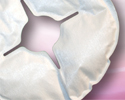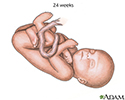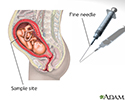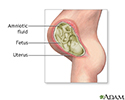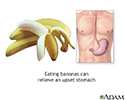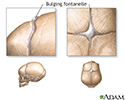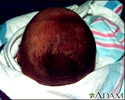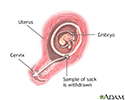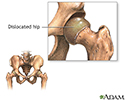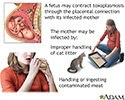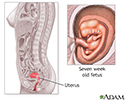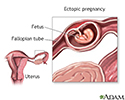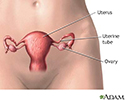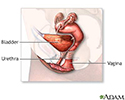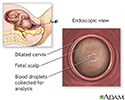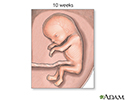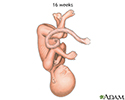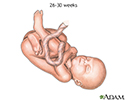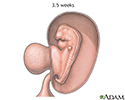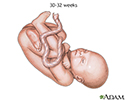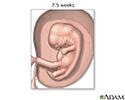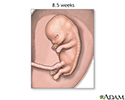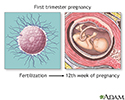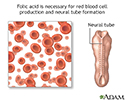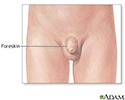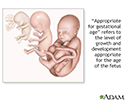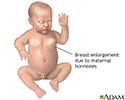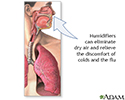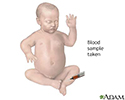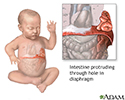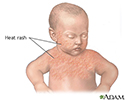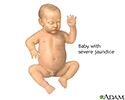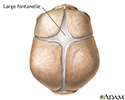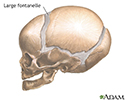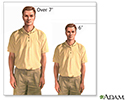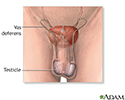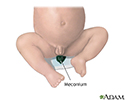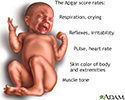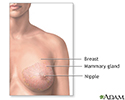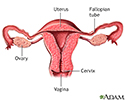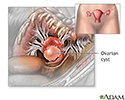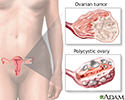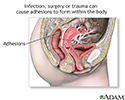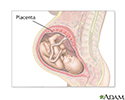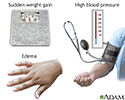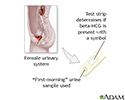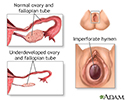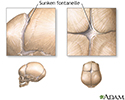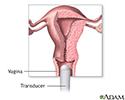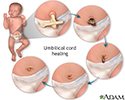Multimedia Gallery
Cesarean section
A cesarean section is a way to deliver a baby by cutting through the skin of the mother's abdomen. Although cesarean (C-sections) are relatively safe surgical procedures, they should only be performed in appropriate medical circumstances.
Some of the most common reasons for a cesarean are:
- If the baby is in a feet first (breech) position.
- If the baby is in a shoulder first (transverse) position.
- If the baby’s head is too large to fit through the birth canal.
- If labor is prolonged and the mother’s cervix will not dilate to 10 centimeters.
- If the mother has placenta previa, where the placenta is blocking the birth canal.
- If there are signs of fetal distress which is when the fetus is in danger because of decreased oxygen flow to the fetus.
Some common causes of fetal distress are:
- Compression of the umbilical cord.
- Compression of major blood vessels in the mother’s abdomen because of her birthing position.
- Maternal illness due to hypertension, anemia, or heart disease.
Like many surgical procedures, cesarean sections require anesthesia. Usually, the mother is given an epidural or a spinal block. Both of these will numb the lower body, but the mother will remain awake. If the baby has to be delivered quickly, as in an emergency, the mother may be given a general anesthetic, which will make her fall asleep. During the surgery, an incision is made in the lower abdomen followed by an incision made in the uterus. There is no pain associated with either of these incisions because of the anesthesia.
The doctor will open the uterus and the amniotic sac. Then the baby is carefully eased through the incision and out into the world. The procedure usually lasts about 20 minutes.
Afterward, the physician delivers the placenta and stitches up the incisions in the uterus and abdominal wall. Usually, the mother is allowed to leave the hospital within a few days, barring complications like wound infections. One concern that many women have is whether they’ll be able to have a normal delivery after having a cesarean. The answer depends on what the reasons were for having the c-section in the first place. If it was because of a one-time problem, like umbilical cord compression or breech position, then the mother may be able to have a normal birth.
Therefore, as long as the mother has had one or two previous cesarean deliveries with a low-transverse uterine incision, and there are no other indications for a cesarean, she is a candidate for vaginal birth after cesarean, also called VBAC.
Cesarean sections are safe, and can even save the lives of both mother and baby during emergency deliveries. Expectant mothers should be prepared for the possibility of having one. Keep in mind, in childbirth, it’s not only the delivery method that matters, but the end result: a healthy mother and baby.
Cesarean section
Review Date: 4/16/2024
Reviewed By: John D. Jacobson, MD, Professor Emeritus, Department of Obstetrics and Gynecology, Loma Linda University School of Medicine, Loma Linda, CA. Also reviewed by David C. Dugdale, MD, Medical Director, Brenda Conaway, Editorial Director, and the A.D.A.M. Editorial team.
Animations
- Breast engorgement
- Cell division
- Cesarean section
- Conception - general
- Conception - pregnancy
- Conception of identical twins
- C-section
- Early labor
- Egg cell production
- Egg production
- Endometriosis
- Fetal ear development
- Formation of twins
- Human face formation
- Infant formulas
- Kids - How big is the baby?
- Kids - How does the baby co...
- Kids - Is it a girl or boy?
- Kids - Umbilical cord
- Kids - Where do babies come...
- Newborn jaundice
- NICU consultants and suppor...
- Ovulation
- Placenta delivery
- Placenta formation
- Preeclampsia
- Pregnancy
- Pregnancy care
- Sperm production
- Sperm release pathway
- Storing breast milk
- The role of amniotic fluid
- Twin-to-twin transfusion sy...
- Ultrasound
- Vaginal delivery
Illustrations
- 24-week fetus
- Abnormal discharge from the...
- Abnormal menstrual periods
- Absence of menstruation (am...
- Amniocentesis
- Amniocentesis
- Amniotic fluid
- Amniotic fluid
- Anatomy of a normal placenta
- Antibodies
- Baby burping position
- Bananas and nausea
- Blood cells
- Blood test
- Breast infection
- Breastfeeding
- Bulging fontanelles
- Candida - fluorescent stain
- Caput succedaneum
- Cesarean section
- Cesarean section
- Cesarean section
- Childbirth
- Chorionic villus sampling
- Congenital hip dislocation
- Congenital toxoplasmosis
- Crying - excessive (0 to 6 ...
- Delivery presentations
- Developmental milestones
- Early weeks of pregnancy
- Ectopic pregnancy
- Emergency Childbirth
- Emergency Childbirth
- Endocrine glands
- Endometriosis
- Endometritis
- Erythroblastosis fetalis - ...
- Female breast
- Female reproductive anatomy
- Female reproductive anatomy
- Female reproductive anatomy...
- Female urinary tract
- Fetal blood testing
- Fetal head molding
- Fetus at 10 weeks
- Fetus at 12 weeks
- Fetus at 16 weeks
- Fetus at 26 to 30 weeks
- Fetus at 3.5 weeks
- Fetus at 30 to 32 weeks
- Fetus at 7.5 weeks
- Fetus at 8.5 weeks
- First trimester of pregnancy
- Folic acid
- Folic acid benefits
- Folic acid source
- Follicle development
- Fontanelles
- Foreskin
- Gestational ages
- Gestational diabetes
- Gonadotropins
- Head circumference
- Heat rash
- Height/weight chart
- Hormonal effects in newborns
- Humidifiers and health
- Hysterectomy
- Infant blood sample
- Infant care following delivery
- Infant diaphragmatic hernia
- Infant heat rash
- Infant intestines
- Infant jaundice
- Infantile reflexes
- Influenza vaccines
- Intraductal papilloma
- Intrauterine transfusion
- Jaundiced infant
- Large fontanelles
- Large fontanelles (lateral view)
- Macrosomia
- Male reproductive anatomy
- Male reproductive anatomy
- Male urinary tract
- Mammary gland
- Meconium
- Morning sickness
- Moro reflex
- Newborn head molding
- Newborn test
- Normal female breast anatomy
- Normal uterine anatomy (cut...
- Ovarian cyst
- Ovarian hypofunction
- Overproductive ovaries
- Pelvic adhesions
- Pelvic laparoscopy
- Placenta
- Placenta
- Placenta
- Placenta previa
- Polyhydramnios
- Preeclampsia
- Pregnancy test
- Primary amenorrhea
- Primary infertility
- Secondary amenorrhea
- Secondary infection
- Side sectional view of fema...
- Single palmar crease
- Skull of a newborn
- Slit-lamp exam
- Sperm
- Stein-Leventhal syndrome
- Sunken fontanelles (superio...
- Tobacco health risks
- Transvaginal ultrasound
- Ultrasound in pregnancy
- Ultrasound, color - normal ...
- Ultrasound, normal fetus - ...
- Ultrasound, normal fetus - ...
- Ultrasound, normal fetus - ...
- Ultrasound, normal fetus - face
- Ultrasound, normal fetus - ...
- Ultrasound, normal fetus - foot
- Ultrasound, normal fetus - ...
- Ultrasound, normal fetus - ...
- Ultrasound, normal fetus - ...
- Ultrasound, normal fetus - ...
- Ultrasound, normal placenta...
- Ultrasound, normal relaxed ...
- Umbilical cord healing
- Uterus
- Vaginal bleeding during pre...
- Well baby visits
- Yeast infections

 Bookmark
Bookmark



























